Low BMR - Consider these points to increase your BMR
- Any kind of aerobic exercise whether you are running or doing zumba, burn calories. Make it more intense, and your body will burn calories.
- Lift weight, because muscle uses more calories than fat, strengthening your muscles will make you into a more efficient calorie burning machine, even when you are at rest.
- Eat plenty of protein at every meal
- Drink green tea
- Get a good night’s sleep
Most importantly let’s discuss about the difference betweeen the Good and Bad Calories.
GOOD CALORIES:
Good calories are those that provide over body with good nutrition. Here is a list of good calories –

- Lean protein helps in body building
- Healthy Fats: Unsaturated Fats ( MUFA, PUFA) fish oil, almonds, walnuts etc
- Complex carbohydrates, whole grains
- Pulses – gives good protein and calories
- Milk(Double tonned), milk products(curd, paneer) give you high protein
BAD CALORIES: Bad calories are those that do not provide over body with good nutrition. Here is a list of bad calories
- Carbonated beverages: it gives high calorie but doesn’t give good nutrition. It can increase blood sugar level due to high sugar content in it.
- Foods with high fat content: It can be a cause of obesity, hyperdislipidaemia. To watch out for – French Fries, Burgers, Kachories, Samosa, Rolls ect.
- PROCESSED FOODS: They are rich in calorie and high in salt content like sausages salami it can be a cause of hypertension, renal disease etc
- TRANS-FAT:Trans fats are certain type of fatty acid that have “ trans chemical structure, which is basically a reconfiguration of the atoms”. Trans fat lasts for long time and low in cost. It increases LDL cholesterol level like margarine, pastry, cookies, Doughnuts etc .
UNIVERSAL RULE OF HEALTHY DIET
The universal diet is also referred to as ‘rules of halved in human dietetics’ as the section or subsection having it. It has a component called ‘diet code’. Assuming a day’s diet as a plate this rule suggests that have of its supply should come from proximate article and other should come from non-proximate one.
- The proximate halve of the plate can be further divided to cereal and non-cereal at 1:1 ratio.
- The cereal portion should have equal representation from whole grains and flour cereals
- The non cereal portion propose to have half proteinus source and the other have as fat source
- The protein halve should be equally represented by plant and animal products
- The animal protein section should further be divided equally to dairy and flesh products which include fish and in addition to regular meat items
- For vegetarians the animal source should be replaced by dairy items and plant source like pulses, soyabeans etc
- The other halve of the the plate should come from fruits and vegetables
- The halve of vegetables should be cooked and the other halve part should be semi cooked or raw again in 1:1 ratio.
- The fruit section should be divided into two parts coloured & non coloured
- All the products for the universal healthy diet should come from organic agricultural source.
Universal diet code
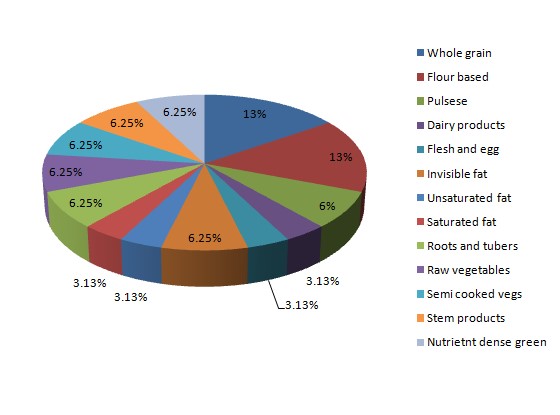
A Healthy Diet Plan For A Young Active Individuals
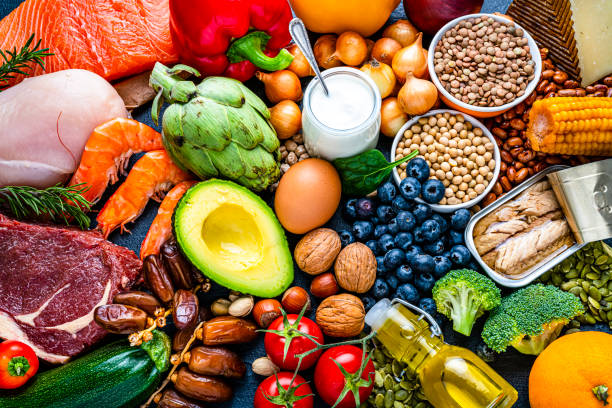
A healthy diet plan for a young active individuals with hectic schedules as follows:
Early Morning : 1 cup of green tea with honey 1 tsp + 2 pcs of protein biscuits
Breakfast: 2 pcs of brown bread / 1 bowl of oats with veg + 2 pcs of poached egg + 1 bowl of fruits + 1 glass of water
Mid Morning: : 3 to 5 pcs of almonds / 5 pcs of walnuts + 1 tbsp of flax seeds + 1 glass of water
Lunch :1 pc of chapatti + 100g of fish/chicken + sauted vegetables (plenty) + 1 bowl of curd + green salad + 1 glass of water
Evening : 1 cup of green tea with honey 1 tsp + 2 pcs of protein biscuits + 1 glass of water
Snacks : 1 bowl of soup + sprout salad with onion , tomato , cucumber, boiled corn. Broccoli sprout etc + 1 glass of water
Dinner : 1 pc of chapatti + 100g of fish/chicken + sauted vegetables (plenty) + 1 bowl of curd + green salad + 1 glass of water
Dietary Guidelines for Obese Elderly People Who Cannot Exercise

Some of the elderly are obese because their consumption of calories has not decreased though there is steady decrease in calorie requirement. Decreasing basal metabolic rate and sedentary lifestyle may be contributing factors. Obese are susceptible to degenerative diseases and mortality rate maybe higher. Maintaining weight promotes healthier ageing and prolongs life span. The trick is to consume enough energy to maintain a healthy weight throughout life and to moderately reduce energy intake as we grow older without reducing our nutrient intake. Energy – Energy requirement decreases with age beyond 30 years. But some of the elderly persons continue to have or consume the same amount of calories like in younger age. It is very difficult to maintain weight for elderly obese adults who cannot exercise as exercise might have helped them to reduce body fat faster, given , if they are physically active. Controlling of portion size and reducing the intake of energy and carbohydrates can significantly help in weight loss. Substituting rice with cheray and muri (puffed rice) can help in weight management for obese elderly. Low calorie foods and and emphasis of the increased consumption of complex carbohydrates like wheat products, oats, brown rice can help such people.
A limited intake of 30g of fat per day may help such people.
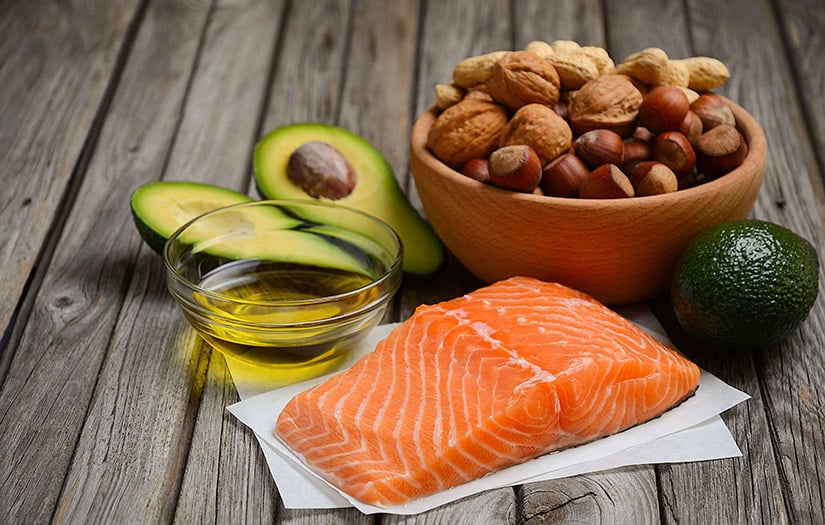
Protein – A protein intake of 1 per kilogram, the normal adult requirement is safe for old age . Since calorie requirements are decreased, the food should be rich in protein compared to normal adult food. Lipids – Emphasis should be placed on reducing the intake of saturated fats such as butter , cheese , red meat and choosing monounsaturated or polyunsaturated fatty acids like fish oils vegetable oils, olives, seeds, nuts which help in conditions such as hair loss, impaired vision, improper digestion, poor kidney function, osteo arthritis and mental depression.
- Select fat-free or low-fat milk and milk products (yoghurt, cottage cheese) to boost calcium intake to maintain healthy bones and prevent osteoporosis.
- Eat seafood, lean meats, poultry and eggs, to boost the intake of high quality protein, vitamin B12, iron and trace minerals such as zinc, selenium and iodine to prevent anaemia, suppressed immune function and thyroid problems
- Include dry beans, peas, lentils and soy products as an excellent source of dietary fiber, vitamins, minerals and plant protein, without added cholesterol or saturated fat. The correct preparation of such legumes is important to make things easier for older people who may have problems with chewing and digestion
- Concentrate on including vegetables as often as possible, particularly dark green or dark yellow vegetables which are rich in beta-carotene (e.g. spinach, butternut, pumpkin, sweet potatoes, peas)
- Try to eat at least 50% of all grains as whole grains (i.e. high-fibre breakfast cereals or porridges, wholegrain breads, rolls and biscuits). Seniors who have problems with chewing high-fibre cereals and grains, may benefit from eating cooked porridges, high-fibre Pro-Nutro and low-GI products like oat bran, porridge ,legumes, peas, corns, carrots, cherries,apple, pears, strawberries , whole wheat products,walnuts, peanuts that contain plant protein as a source of dietary fibre.
- Use alcohol in moderation – only one drink per day for women and two drinks a day for men – and not necessarily every day. Alcohol should never take the place of nutrient-dense foods and drinks such as milk
- Limiting intake of sodium , solid fats, limiting intake of added sugar, undiluted fruit juices and refined grains can significantly help such individuals.
- In case if the person has chewing and swallowing problems, mashed foods or rather a soft diet in form of soft porridge, grinded oats , fruit puree, boiled and mashed nuts, soft tender lean meat cooked in gravy can be the dietary modifications in such case.
- Increase intake of dietary calcium and vitamin D to boost metabolism, and make bones strong.
Low calorie, increased intake of plant protein and lean meat, intake of good fat, and increasing intake of vitamins and minerals and water intake before every meal can significantly help such elderly obese individuals to maintain their ideal body weight.
Foods That Detox the Body
Detoxification or detoxication (detox for short) is the physiological or medicinal removal of toxic substances from a living organism, including the human body, which is mainly carried out by the liver. An animal’s metabolism can produce harmful substances which it can then make less toxic through reduction, oxidation (collectively known as redox reactions), conjugation and excretion of molecules from cells or tissues.[9] This is called xenobiotic metabolism.Enzymes that are important in detoxification metabolism include cytochrome P450 oxidases, UDP-glucuronosyltransferases, and glutathione S-transferases. Smooth digestion and absorption of nutrients along with liver’s efficient processing of toxins are absolutely critical for great health. That’s why a cleans programme can be a powerful tool to rejuvenate your body and skin from the inside out. Progressively eliminate alcohol, coffee, cigarettes, refined sugars, saturated fats and all processed food, these are recommended as toxins in your body.Increase fibre intake to help to keep your colon clean along with the fibre from fruits and vegetables include two tablespoons of flax seeds, chia seeds in a glass of water to eliminate toxins from your body. Do not forget to drink at least eight glasses of water per day. The followin is the general guideline of DETOX DIET MENU: Start the morning with half a lemon squeezed into warm water or cleansing herb tea. Follow with a brisk walk, yoga or swimming.
- Breakfast – Fresh vegetable juice (carrots, beetroot, mint, coriander, parsley, swpinach, kale). Add a tablespoon of chia seeds to your juice for that extra fibre and power boost. One cup of curd with sliced fresh fruits, sprinkle with chia seeds, sliced almonds and walnuts. Drizzle with a little raw honey if desired.
- Lunch – Vegetables: Grilled mushroom or soyabean, spinach, fenugreek leaves, beetroot, broccoli, cabbage, pumpkins, carrots, onion, garlic, ginger with olive oil and a splash of lemon juice. Accompany with handful of almonds and raisins. 1 bowl of Moong dal.
- Snacks – Make a trail mix of nuts and seeds like walnuts, almonds, pumpkin seeds, chia seeds and flax seeds. Eat low GI fruits like guava, pear, apple, orange, strawberries, peach, apricot, kiwi,etc.
- Dinner – Grilled mushroom with green salad, sweet potato smashed and half cup of brown rice
GENERAL GUIDELINES FOR OBESE CHILDREN AS FOLLOWS

What to do?
OBESITY IS A STATE IN WHICH THERE IS A GENERALISED ACCUMULATION OF EXCESS ADIPOSE TISSUE IN THE BODY LEADING TO MORE THAN 20 PERCENT OF THE DESIRABLE WEIGHT.OVER WEIGHT IS A CONDITION WHERE THE BODY WEIGHT IS 10-20 PER GREATER THAN THE MEAN Standard weight for age, height and sex .Obesity invites disability ,disease and predisposes a person to disease like atherosclerosis ,high blood pressure,stroke,diabetes,gall bladder diseases and osteoarthritis of weight bearing joints and varicose veins . Obesity is a chronic disease. Usually obesity is due to positive energy balnce. That is, the intake of calories is more than the expenditure of calories.
Principles of Dietetic management
Low calorie,high protein normal vitamin and mineral (except sodium),restricted carbohydrates, restricted fat and liberal fluid, high fibre diet are given in such cases.
About 20 kcal per kg body weightis precribed for a sedentary worker and 25kcal for moderately active worker.
About 1- 1.2gm of protein per kg body weight is prescribed .
High carbs content foods like potatoes and rice are restricted.Sugar which gives empty calories should be totally avoided.Fruits rich in carbohydrate like Banana should be avoided.
Saturated fat like ghee Banaspati Butter pastries should be avoided.
With prolonged restriction of fats,there is likely to be a restriction of fat soluble vitamins A and D which may be supplemented.
Restriction of sodium as common salt is helpful in weight reducing diet as excess sodium predisposes to retention of fluid .
Fluids can be taken liberally as extra fluids are excreted by healthy kidneys.Also aglass of water before meals helps to cut down food intake.
High Fiber: High fibre low calorie foods like green leafy vegetables, fruits, vegetables salads, whole grain cereals and pulses can be included in the diet. Inclusion of high fibre foods in diets for obese has many advantages. They are
- Low in calorie density
- Foods like greens provide many vitamins and minerals
- Give satiety
- Help in regulating bowel movements
- Reduce blood cholesterol
- Promote chewing and decreases rate of ingestion
Other General Guidelines
- Low GI foods may benefit in weight control.
- The patient should be convienced that there is no other way of reducing weight except by consuming less calories than needed by the body.
- The diet should be adequate in all other nutrients except kilo calories.It should be high in fibre.
- Rejecting sweets should become natural way of life.
- Excercise reduces body fat and increases muscle mass brings down blood pressure, blood sugar blood cholesterol reducess stress and improves feeling of well being.
- Obese patient should be encouraged to eat “unprocessed” foods and foods in their natural forms.
- They should limit fat, sucrose and alcohol.
SUGGESTED RECIPIES
What is it?
Receipes which will give fullness as well as low in calorie:
What to do?
Food —— Reason
- VEGETABLE SALADS : LOW CALORIE AND HIGH FIBRE
- CHAPATHIS WITHOUT OIL : MORE PROTEINS AND HIGH FIBRE AND GIVE SATIETY
- THIN DALS STEAMED FOODS LIKE IDLI : TO LIMIT CALORIES,INCREASE PROTEIN CONTENT
- SOUPS : LOW CALORIE VALUE PROVIDES FULLNES
- POACHED EGG FISH CHICKEN : LOW CALORIES HIGH IN PROTEIN OF GOOD QUALITY
IMPORTANCE OF EATING MEALS ON TIME
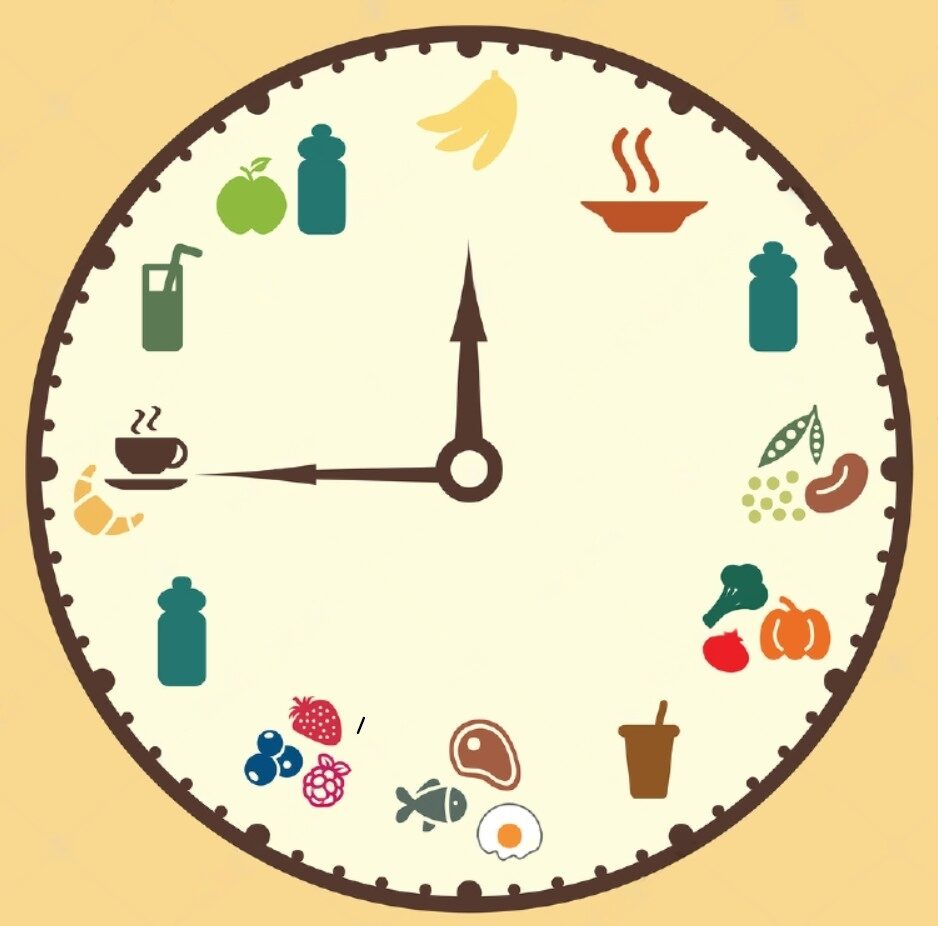
It is important to eat meals to ensure your body gets the energy it needs to perform . To prevent big hunger pangs between meals and overindulging at main meals times,spread your food intake over five to six smaller meals and snacks. Abnormal or irregular eating habit is one of the greatest mistakes that will affect your health. Skipping meals and not eating on time can affect the normal balance of your body functions. Good Foods For Immune System Always keep a regular timetable for your food timing. Human body works in a rhythm and all our body functions are following this. When you are not taking food in time, this will result in many metabolic disorders. This will ultimately lead to health issues like diabetes, obesity, heart diseases and digestive disturbances. In this modern time, when people are working even in night, it is difficult to maintain proper timing for food intake. But, if you are careful about your health, know the importance of eating on time and arrange your meals in proper way
ANTIOXIDANTS
Antioxidant protects the body from damage caused by harmful molecules called free radicals. Many experts belive this damage is a factor in development of blood vessel diaease , cancer. Free radicals are atoms or group of atoms with an odd (unpaired) number of electrons and can be formed when oxygen interacts with certain molecules. Once form these highly reactive radicalscan start a chain reactions reactions and cause damage the important cellular components, such as DNA or cell membrane. Cells may function poorly if this occur. To prevent free radicals damage, the body has a defence system of antioxidants. Antioxidants are molecules which can safely interact with free radicals and terminates the reaction before vital molecules are damageed.Although there are several enzymes system within the body that scavanges free radicals.
The principle micronutrient antioxidants are
- Vitamin E: a fat soluble vitamin present in nuts ,seeds, vegetable and fish oil, whole grain (sp- wheat grains),fortified cereals and apricot. Current recommendation daily allowances (RDA) IS 15(IU) PER DAY and 12 IU PER DAY for women.
- VITAMIN C: It is a water soluble vitamin present in citrus fruits, juice black pepper, cabbage spinach brocoli kale kiwi and strawberries. The RDA IS 60 mg per day. Intake above 200mg be associate with adverse side effects in same individuals
- BETA CAROTENE: It is a precursor of vitamin A and is present in liver, egg yolk, milk , milk, butter, spinach , carrots, squash, brocoli, tomato, and grains. Beta carotene is converted to vitamin A
- SELENIUM a trace metal that is required for proper function of one of the body’s antioxidant enzyme system
ROLE OF WATER IN DETOXIFICATION
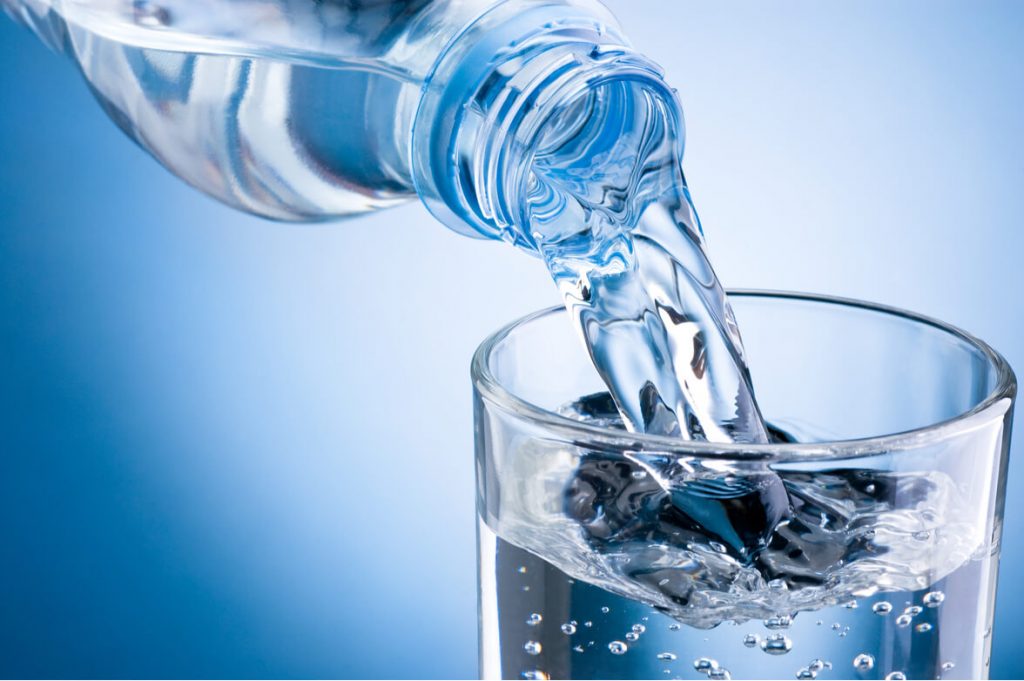
What is it?
Water flushes toxins and waste from the body and transports nutrients to where they are needed. Without water the contents of your colon can dry out and get stuck, eventually causing constipation. Water is a natural lubricant that softens stool and promotes evacuation of the bowels. Our kidney system is unique in its filtering capabilities and totally dependent upon water in order for it to work. The kidneys remove waste products from the blood, eliminate toxic substances in the urine.. They filter voluminous amounts of blood each day and in doing so maintain the body’s water balance and excrete toxins and excess fluid through the bladder. Daily fluid intake is essential for our bodies to function efficiently. The kidneys and liver are organs of detoxification and elimination that help your body filter waste. The kidneys regulate sodium and mineral levels, excreting extra salts so that toxins do not build up in your body. The liver, largest internal organ, aids in digestion, produces bile to break down fats and absorb nutrients and rids the body of toxic substances. . Water makes up a large part of the body, and is essential for your survival. Drinking a lot of water is important during liver detoxification. Water flushes the liver tissues, aiding in removing toxins, and also assists the kidneys during a liver detox, so the liver can focus on its own cleansing. Adding lemon to water also helps in the detoxification process, stimulating bile to remove toxins.
